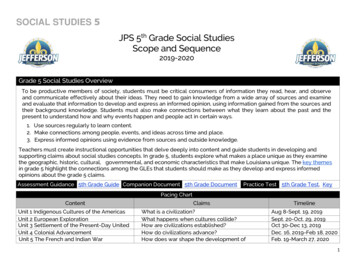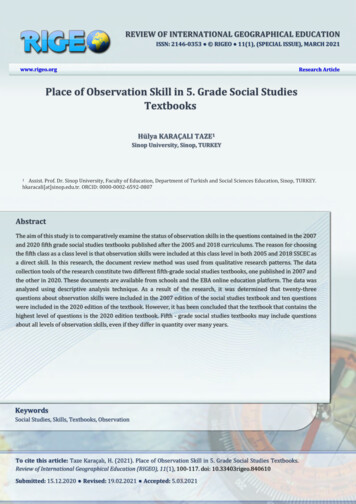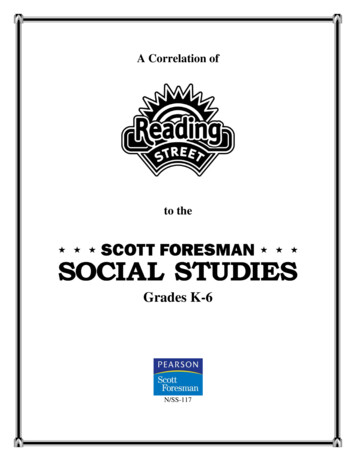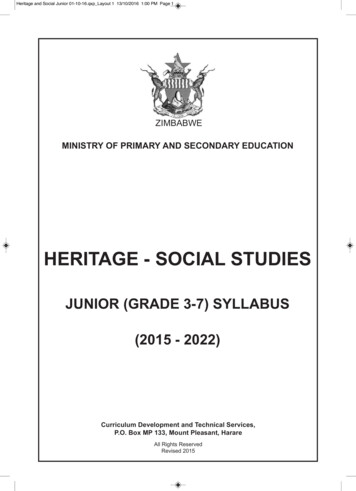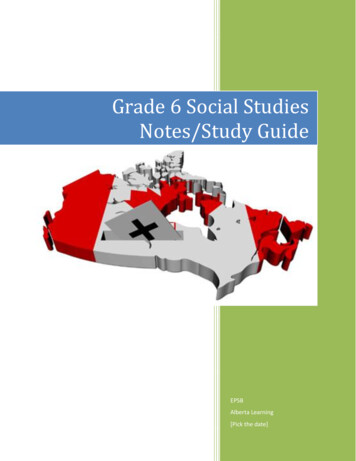
Transcription
Grade 6 Social StudiesNotes/Study GuideEPSBAlberta Learning[Pick the date]
Democracy Study GuideDemocracy is a form of government in which everyone has certainrights that are balanced by responsibilities. Citizens have the rightand responsibility to choose the people who govern them.A democratic system is one in which citizens have a voice in decisionmaking. There are four main principles to think about when talkingdemocracy, equity, freedoms, justice and representation.Rights – in a democracy, are things specifically allowed, and theyprovide protection to the people of a country by their government. Ina democracy, it’s the government job to protect our rights andfreedoms.Responsibilities – Responsibilities are the duties of an individual orgroup in our society. It is something that you are expected to do.In Canada with every right, there is a responsibility. Some of theresponsibilities in society include obeying the laws, paying taxes,voting, speaking up about discrimination and injustice, and beinginvolved in your community.Four Pillars of DemocracyJustice – fair treatment of individual and groups. Upholding just, fairand equitable treatment, and providing due reward in accordance withhonour, standards, or laws. Justice means we have a system to makesure that everyone is treated fairly. If a citizen or government makesa decision that is not fair there will be consequences.Equity – treating people fairly; sometimes accommodations need to bemade so that things will be equal or fair for everyone. Being fair andjust!
Freedoms – are about things the government and others are notallowed to stop you from doing. Freedoms, in a democracy, mean thatpeople can act without interference from others or the government.Representation – in a representative democracy citizens elect theirrepresentatives to govern and make decisions on their behalf.In Canada we choose people who form the government and they makedecisions for us. These representatives have a responsibility to listento the needs of all citizens. We choose our representative by votingfor them. La Grande Paix de Montreal is an early example ofrepresentation.Direct and Representative DemocracyDirect democracy: a way of making decisions in which everyone in agroup votes (no representatives are involved). All citizens areinvolved in decision making.·E.g. Athenian societyRepresentative Democracy: citizens elect people to represent them ingovernment. These people make decisions on behalf of citizens.·E.g. Canadian societySimilarities between Direct and Representative Democracies:·People are involved in decision making·Citizens are voting·Pillars of democracy: representation, justice, freedom andequityDifferences between Direct and Representative Democracies:·In direct democracy, the people who vote make thedecisions. No representatives are involved and every citizenhas a vote. In Athenian society, only Athenian-born men freewith Athenian-born parents were able to vote. These men
·made the decisions for the entire society. In the Iroquoisconfederacy, every person had a vote and participated indecision making process.In representative democracy, decisions are made by peopleelected by the people they represent. Representatives areaccountable (held responsible) for communicating with theirpeople, making decisions on their behalf, and working to helpthem. In Canadian society, these people are called Member ofthe Legislative Assembly (MLA) at the provincial level andMembers of Parliament (MP) at the federal level.Charter of Rights and FreedomsThe Charter of Rights and Freedoms is a document that protects theessential rights and freedoms of people living in Canada. Having theCharter entrenched in the Constitution means that no one, includingthe government can take away the rights and freedoms of the peopleof Canada. The freedoms are “subject to reasonable limits.” Thegovernment can limit a person’s right or freedom, but it must show whythe limit is necessary. The courts in Canada uphold our rights underthe Charter. A person or group who feels that their right has beentaken away can undergo an Appeal Process in our Court System. Therights and freedoms contained in the document are as follows:Fundamental Freedoms:·To have and express your opinion.·To belong to any group.·To organize peaceful meetings and demonstrations.·To practice your religion.Democratic Rights:·To vote for candidates in elections.·To participate in an Election.
··To have legislatures and Parliament meet at least once ayear.To have elections at least every five years.Individual Rights:·Rights that you are entitled to as a person.Equality Rights:·All Canadian laws must treat each individual with dignityand respect regardless of the person’s race, religion, nationalor ethnic origin, color, gender, age or physical or mentaldisabilities.Collective Rights:·Protect a group. Individuals who are part of a group thathas collective rights are entitled to these rights.·Collective identity – Sense of belonging to a community ofgroup, established and strengthened through commoncharacteristics and interests. Culture, and language aredetermining factors in the formation of collective identity.Aboriginal Rights :·Aboriginal people have rights to their traditionalterritories.Language Rights :·French and English are Canada’s official languages. TheCharter recognizes the rights of the English and FrenchSpeaking communities.Protecting our Rights
Court SystemThe court system in Canada protects our rights and freedoms. Aperson or group who thinks a right or freedom has been taken awaytakes the case to a provincial court. The court makes a decision, buteither side can appeal if they believe the decision was unfair. Appealmeans to ask a higher court to review a decision made by a lowercourt. The highest court in Canada, The Supreme Court, considers themost important cases and their decision is final.ConstitutionOur Constitution is the highest law of the land. It is a set ofprinciples that lays out the rules for how our country will begoverned. The Constitution is very difficult to changeThe Charter was entrenched (firmly established) in the Constitution sothat rights would be more effectively protected. The followingreasons outline why it was essential for the CCRF to be part of theConstitution:1.No one, including the government, can take away the rightsand freedoms of people in Canada.2.Laws that do not align with the Charter will be quickly struckdown3.Provincial and federal leaders must negotiate and agreebefore any changes can be made to the Constitution4.All minority groups are protectedWhy do we need government?The purpose of government is to make sure that the people in a societyhave safe, comfortable lives.Government provides services. People have certain needs, such asfood and shelter. Our families provide these needs for us. We alsoneed schools, hospitals, libraries, courts of law, police, public
transportation, community centres, and services for seniors. Peoplecannot do all these things for themselves. One reason that peoplecreated government was so that there would be a structure to takecare of the needs of everyone in society.Government protects rights and freedoms. In a democracy, peoplehave certain rights and freedoms. The government’s job is to protectour rights and freedoms, for example, our freedom of religion and theright to be considered innocent until proven guilty in a court of law.Government provides leadership. The government takes actions thataffect our society in many ways. These include making decisions aboutthe environment, resources, and relations with other countries.What Are Our Responsibilities as Citizens?Representatives of the people make decisions on our behalf. Thedecisions might be about closing a public swimming pool, opening a newschool, or setting the fee for a dog license. The government alsomakes decisions such as sending troops to act as peacekeepers inanother country. In order to make good decisions, governments needto listen to what the people need and want. Governments rely on thepeople for information that will help with these decisions. People havea responsibility to inform the government of what they want and need.They have a responsibility to make their point of view known and tolisten and try to understand the points of view of others.
Values:Are principles about how people should act. Values are also standardsfor what we consider important and just. Canadians describethemselves as having the following values: the fair and equal treatment of all a respectful or sensitive attitude towardothers who havedifferent opinions from their own a belief in solving differences in a peacefulway discussion and compromise as ways to reachdecisions support for diversity Our values are part of our identity.Injustice: Is an action that is not fair to a group and/or individual.Society and Society’s Rules:A Society is a group of people that share the same government andthe same rules and laws. A society may also be a group of people whohave the same interests or culture. You may be part of many societieswithin Canadian society.People in a society need rules to help them get along with one another.Rules guide how we act with others in our home, our school, ourcommunity, and our country. Rules help us resolve conflicts in apeaceful way. The basic rules in Canada are in our Constitution.
Ancient Athens Study GuidePrimary sources – are writings and objects that were created bypeople living at a certain timeInscription – important sources of information that are carved onstone, wood, and metal surfaces, therefore lasting hundreds orthousands of yearsDirect democracy – people vote directly to make decisions ratherthan having representativesDecree – a decision made by people who are in authorityOrator – someone who speaks in publicStructure of Government in AthensThey developed a system of government allowing citizens toparticipate in making important decisions. Today we know this asdemocracy. There are three institutions that make up the pillars ofAthenian democracy, the Assembly, the Council of 500, and The Court.Assembly All men who were citizens could take part in debating issuesand voting on laws. A minimum of 6000 people present to have a vote count. Each member had an equal right to speech. Example of direct democracy because they voted directly ongovernment decisions. A decision was made based on a majority vote called adecree. Met about 40 times per year (every 8 – 10 days) They discussed large issues such as war and religion but alsoprivate concerns.
Met in a large open area at the top of a hill call the Pnyx. Members made speeches, debate, listen, discuss, and finallyvote.Council of 500Also known as the Bouleuterion (Boule)Was the full time government in Athens.Council members’ terms lasted only one year.Positions were chosen using a lottery method.You could only serve on the council twice in yourlifetime. Council leaders only had the position for 24hours. Their job was to supervise how the governmentwas run. Divided into ten tribes 50 members from each tribe over the age of 30served on the council Athenian Court If citizens felt that they had been wronged, theywould bring their concerns to the magistrate. Magistrates (Judges) were citizens and officers ofthe court who were chosen by lottery for a one yearterm. Sometimes fines would be set, other times they wouldsend the case to trial.
Class Structure and Citizenship in AncientAthensA person’s class (slave, Athenian-born or Metic) determined theirrights and responsibilities. The democratic principles ofrepresentation, equity and fairness only applied fully to male citizens.Men2 classes: Citizens or MeticsCitizens:Free, born in AthensSent sons to school and owned propertyPaid taxesExpected to serve in government positions, vote, and performmilitary service Only citizens could participate in government. A young man became a citizen after he finished his military serviceat age 20. Metics: - not citizensForeigners living in AthensThey could send sons to school. (if they could afford it.)They couldn’t own property without permission.They needed a citizen to sponsor them, otherwise they couldbecome enslaved. They could not vote or hold government positions Expected to perform military service
Women2 Classes: Athenian or Metics – neither were citizensAthenian Women: Caregivers and home managersCould own propertyCould influence citizens (influencing husbands)Could not voteCould not participate in governmentMetics (Women): Caregivers and home managersCould not own propertyCould not voteCould not participate in governmentCould not influence citizensChildrenBoys:Attend school (if they could afford it), If school was too expensive,they would help in the family business, expected to have militarytraining. Athenian boys would become citizens, but Metic boys wouldnot.Girls:Stay home and learn household skills
Slaveso Men, women and children who were bought and sold byotherso Could not own land,o Could not make day to day decisions about their lifeo Did not participate in government or voteo Could not ever become a citizenWhat ideas of fairness, equity, and rights were part ofAthenian democracy? The most important idea was that it is fair that citizens beallowed to rule themselves. This is the basis of democracy. Athenians believed that majority rule was fair. This meantthat decisions were made by voting and that law supportedby more than half the voters was passed. Athenians believed that people who belonged to the sameclass in society should have equal rights. All male citizenshad the right to belong to the assembly and vote. (The onlyexceptions were people who committed acts that wouldcause them to lose their citizenship and these were clearlylaid out in law). Women, slaves and metics were denied voting rights. Slavery was an accepted part of Athenian society. Aperson’s right to own another person was not questioned,even by great Athenian thinkers like Socrates) Individual and minority rights were not part of thethinking of Athenian democracy. The common good was thehighest value.
Iroquois ConfederacyStudy GuideI CANS - Do you understand. How was the Iroquois Confederacy structured? What was the role and status of women within the IroquoisConfederacy? What are the advantages and disadvantages of consensus as adecision-making model for gov’t? How did the Six Nations use the consensus-building process? How did the Wampum Belt address collective identity? How did the social structure of the Iroquois Confederacy impactits political structure? To what extent did the decision-making process within theIroquois Confederacy reflect democratic ideals of equity andfairness?Below are some questions/answers to think about1. What is the Great Law?In Modern Canada the “Constitution” that sets out therules of Canadian society. The Great Law of Peace is theconstitution of the Iroquois. It describes principles ofgood living and tells how the Confederacy should beorganized and run.2. What is the role of women in the Iroquois Confederacy?Women had positions of respect in Iroquois society. CarolJacobs, Cayuga Bear Clan Mother, describes women’sstanding this way: “In our traditions, it is women who carry
the seeds, both of our own future generations and of theplant life. It is women who plant and tend the gardens, andwomen who bear and raise the children. ”Women also ownedthe property and homes. When a woman got married, herhusband would come to live in her family’s longhouse. Theirchildren belonged to the mother’s clan. The women raisedcorn, beans, and squash, which were the main food supply ofthe Iroquois. These crops are known as the “Three Sisters.”3. Describe the role of the clan mothers.Clan mothers were the leaders of the clan. The title of clanmother was usually passed on to her female relatives: hersisters or her daughters. The Great Law of Peace gave theclan mother ownership of the chieftainship title. This meansthat clan mothers had the responsibility of selecting thechiefs for their own clan. Clan mothers today have as muchimportance and respect as they did in the past.In choosing a chief, the clan mother would look for characteristicssuch as: honesty and kind-heartedness ability to think clearly knowledge of traditional ceremonies loyalty to family ability to uphold the Great Law ability to represent the people fairly ability to withstand criticism
4. Look at the Wampum Belt and explain what a Wampum Beltrepresents.Long before there were telephones, identification cards, orwritten agreements, wampum was used by the Haudenosauneeto communicate messages and important ideas. Wampum wasalso proof that an individual had the authority to speak forthe people and provided a way to record agreements betweennations. This is still true today. Chiefs and Clan Mothershave their own strings of wampum that symbolize theirposition of honor and responsibility in the community.Wampum strings are used in ceremonies and also at councilmeetings where it is passed to each person present so thatall will remember, and live by, its message.5. How does the Wampum Belt show collective identity?Because many of the patterns are the same/similar on eachgroup/tribes wampum belts; as well as the fact that WampumBelts often signified treaties between groups. Since theyshare common culture, laws, and beliefs. The patterns on thebelts show that the nations of the Iroquois Confederacyshared a collective identity.
6. What type of government was the Iroquois? Direct orrepresentative? How do you know?Representative Democracy: The Great Law of Peaceestablished a Grand Council made up of 50 chiefs whorepresented the nations of the Confederacy. Nations withlarge populations had more chiefs than smaller nations, butthey were all equal to one another.7. What is the role of the Chief?They are the leaders in Iroquois society were the chiefs.The Great Law of Peace stated that it was their duty tobe teachers and spiritual guides and to remind their peoplethat the Creator wants them to live together forever inpeace. The chiefs were treated with great respectbecause of their wisdom and other special qualities.However, they were considered the same as everyone elsein society—not better or above others. They were thecaretakers of the Great Law of Peace and hadresponsibilities in many areas. The chiefs looked after thewelfare of their people and ran the affairs of the clan,the nation, and the Confederacy. They also upheld therule of law in their society.There were also: War chiefs, who were selected by each of the nationsto sit on the Grand Council. In wartime, these chiefs hadto gather warriors for fighting. Pine tree chiefs, who showed special abilities or had aninterest in public affairs. They were selected to join theGrand Council by its chiefs.8. How are the chiefs chosen? By who and what characteristicsshould they have?
New chiefs were chosen by the clan mothers. The clanmothers also ensured that all decisions made by the GrandCouncil agreed with the Great Law of Peace. The GreatLaw of Peace said the Chief had to put the needs of theirpeople first. The Clan Mothers could replace the chief ifthey failed to do a good job.In choosing a chief, the clan mother would look forcharacteristics such as: honesty and kind-heartedness ability to think clearly knowledge of traditional ceremonies loyalty to family ability to uphold the Great Law ability to represent the people fairly ability to withstand criticism9. What is the Grand Council? Essentially the “Government” ofthe Iroquois Confederacy. The Grand Council met todiscuss issues that affected the whole Confederacy, suchas peace treaties, trade agreements, and decisions to goto war. The Grand Council was made up of the Chiefs fromeach nation — 50 in all. Although they rarely spoke atGrand Council meetings, all Iroquois people — men andwomen — had ways to make their voices heard in thedecision making of the Grand Council. Through theWomen’s Councils and Men’s Councils of their clans, theyadvised the Clan Mothers of their positions on issues.10. How were decisions made in the Iroquois Confederacy? Whatis consensus?The Great Law was written to ensure that the Iroquoiscould live together in peace and harmony. Here are someways that democratic principles are built into decision
making under the Great Law: Although different nationshad different numbers of chiefs in the Grand Council,there was equality among them. They all had the samelevel of authority. Authority was shared between men andwomen. Although only men were members of the GrandCouncil, it was the women who nominated the chiefs andcould take away their title. The fact that people belongedto their mother’s clan also gave authority to the women.The clan system introduced by the Peacemaker helped tomake sure that no one nation would ever be able to takeover the Confederacy. Because people in each nationbelonged to various clans, their loyalty was split betweentheir clan and their nation. This balancing of loyaltyworked to maintain democracy and unity within theConfederacy.Making Decisions by ConsensusCan you imagine how hard it would be to get all of thestudents in your class to agree on an issue? How would yougo about it? Getting five different nations and the manyclans within them to agree on issues was a challenge thatthe Peacemaker faced. The Great Law sets out a systemof decision making that allows everyone a voice andrequires the agreement of all. This way of makingdecisions is called consensus. It was another way thatfairness and equality were maintained in Iroquois society.Consensus requires people to be open-minded. They mustbe willing to think deeply about the issue and to listen tothe opinions of others. The decision may not be their firstchoice, but they must be willing to support it in the bestinterest of the group.
11. Explain the Seventh Generation.One important responsibility of the Grand Council was toconsider the seventh generation. The chiefs had to alwayskeep in mind how the decisions they made would affectthe lives of their people for seven generations—more than200 years in the future. This encouraged the chiefs toact cautiously so that the welfare of their descendantswould be protected.Below are vocabulary words that you should know:Clan mother - the leaders of each clan, responsible for choosing a chief andmonitoring his actionsClan system - A system of that ensured that there was a balancing of loyaltybetween ones clan and nation, to maintain democracy and unity within theConfederacyWampum Belts - a string or belt that hold a message of collective identityHiawatha Wampum - a wampum that represented the Nations workingtogether in peace. It describes the Great Law.Collective Identity - a shared belief system that often includes the samelanguage, culture, values, and attitudesClan - a large group of families who are related to one anotherLonghouse – the center of the Iroquois society where the families lived. As thefamily grew, so did the long house.Confederacy - a partnership that is agreed on by nations or groups of peopleHaudenosaunee- name that the people of the Six Nations call themselvesWar Chiefs - people who were selected by each of the nations to sit on theGrand Council. In wartime, these chiefs had to gather warriors for fighting
Pine Tree Chiefs - people with special abilities or interests in public affairs,selected to join the Grand Council by its chiefsSeventh Generation - considering generations 200 years in the futureConsensus - when all people affected by a decision have a voice, and theagreement of all is requiredPolitical Map - a map that tells the location of countries and citiesHistorical Map - a map that tells what an area was like in the pastPhysical Map - a map that provides information about features of the landlike rivers, mountains and land elevation
Local Government Study GuideElectoral ProcessElection: a democratic way to select a representativeRepresentative: a person elected by the people to represent thepeople. Any Canadian citizen over the age of 18 can run for office(become a Candidate)Steps of a Local Election: Nomination - Must be nominated to get name on voting ballot(papers with personal info and names of people who havenominated you are delivered to municipal offices) Name goes onvoting ballot (a piece of paper used for voting that lists thenames of the candidates) Campaigning - Gain support through campaign committees,debate, door to door knocking, leaflets and signs Voting: People go to polling station to vote. Person with themost amount of votes wins. Voting is a democratic way to voiceyour opinionWhy do we have Local Government?Local government is created to provide services to meet some of theneeds of its citizens.Local Government ServicesPublic TransportationFire ProtectionWaste DisposalParks and RecreationAnimal Control
LibrariesStreets and RoadsSenior’s FacilitiesSchool BoardsTaxes Local government collects the money for the above servicesthrough tax collection. Taxes collected from the people who ownproperty in the community:Such as housesSuch as businessesSuch as land Money collected by taxes is called revenue or income for thelocal government to spend on the above services. When the local government spends its money it is calledexpenditures, or expenses.Bylaws – are rules, at the local level, that specify people’s behaviour inorder to help keep people safe and help community run smoothly.Bylaws can only be enforced in areas they have been passed. People areresponsible for knowing and obeying bylaws of that community andcould be fined if rules are not followed.New Bylaws or Changes to Bylaws Motion (idea or proposal discussed and voted on at a meeting) isintroduced by a councillor. A person or group can make a presentation at a council meeting People have 3 chances to speak out against it. Supporters cananswer criticisms each time. Motion is put to a vote. If the Majority of councillors vote infavour, it will be passed and become a bylaw.
Urban vs. Rural GovernmentsMunicipalities are broken up according to population. An area with ahigh population in a small area is urban whereas an area with a lowpopulation in a large area is rural.Local GovernmentTop Elected OfficialUrban– cities, townsand villages.Mayor Usually elected byvoterRural – includemunicipal districtsand countiesReeve Councillor electedas chief electoralofficer by councilFirst NationsChief Elected by votersin First NationcommunitiesMétisChairperson Selected by councilmembersCouncilCouncillors Between 7 and 15depending on sizeof community; 7for towns Elected by votersCouncillors Usually 3 forvillages Elected by votersCouncil is selected bycommunity Number ofcouncillors dependson size of FirstNationCouncil of 5 Selected bycommunityMunicipal District – is a rural area that has its own local government
Other Types of Local GovernmentsSchool BoardsSchool Board - is a type of local government that makes decisionsabout education services and programs in schools. They know the needsand values of the community and makes decisions that are appropriateto these needs.Superintendent - is responsible for running the schools in ajurisdiction (name of area that covers all schools ex. Christ theRedeemer, Calgary Catholic), hired by school board.Trustee – voted member of the community who serves on a schoolboard.Types of School BoardsPublic Schools – are open to all students, they may have FrenchImmersion or bilingual programs in languages such as Chinese, Arabicor Ukrainian. They may also have special needs programsSeparate Schools – have instruction in the Roman Catholic faith aswell as a wide variety of language programs.Francophone Schools – all Francophone schools are run by Francophoneschool boards unless they are private. Canada’s Charter of Rights andFreedoms gives Francophone parents in Alberta the right to have theirchildren educated in French.Charter Schools – are not governed by the local school board. Theyhave the same curriculum as public schools, but with a special focus,such as science, music or athletics.
First Nation Schools – are run by First Nations bands and often focuson aspects of the First Nations culture such as language.Association Canadienne-Française de l’Alberta (ACFA)What is the purpose of ACFA? To advance and broaden the vision of Alberta’s entirefrancophone community. To bring together, plan, mobilize, support and inspire the vitalforces of Alberta’s francophone community To defend the official language rights of the francophonecitizens of AB To provide a voice on issues that concern the francophonecommunity as a wholeHow does the ACFA make decisions? Members discuss issues and activities at an annual generalmeeting Members who are 16 yrs of age and older can attend the AGMand vote The vote of every member is equally important Members elect representatives to the board of directors.These include representatives for each region, members atlarge, and a Provincial PresidentMétis Nation of Alberta Association (MNAA)What is the purpose of the Métis Nation of Alberta? To improve the education, health, social and economic conditionsof Alberta’s Métis people To speak on behalf of the Métis to governments, industry, andcommunities To provide Métis people opportunities to participate ingovernment policies and decisions To promote Métis rights
To apply for gov’t grants, and carry out gov’t programs andservicesHow does MNA make decisions?All members have equal decision making powersA general assembly each year discuss’s policies and activitiesAll members elect a provincial president and vice presidentEach of the 6 regions has a regional council with an electedregional president and vice president and Métis representatives The provincial council of the MNA i
Grade 6 Social Studies Notes/Study Guide . Democracy Study Guide Democracy is a form of government in which everyone has certain rights that are balanced by responsibilities. Citizens have the right


